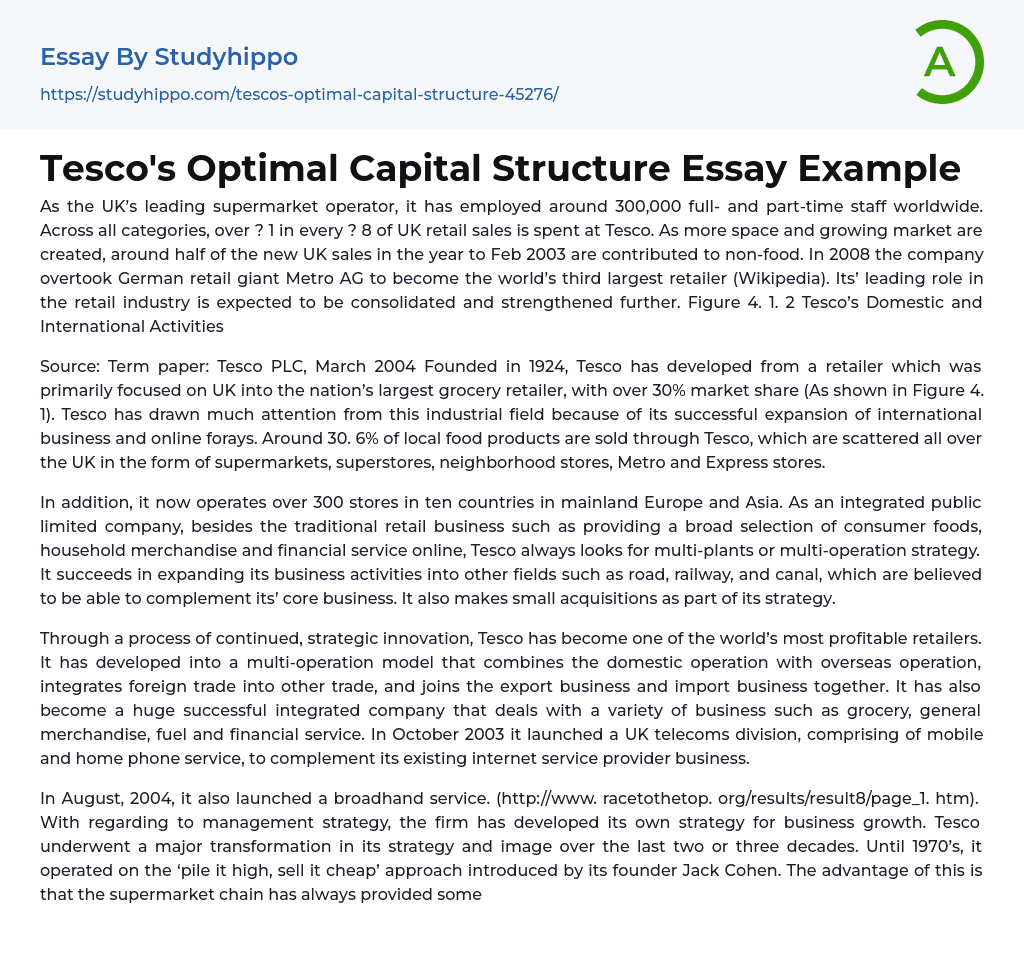As the UK’s leading supermarket operator, it has employed around 300,000 full- and part-time staff worldwide. Across all categories, over ? 1 in every ? 8 of UK retail sales is spent at Tesco. As more space and growing market are created, around half of the new UK sales in the year to Feb 2003 are contributed to non-food. In 2008 the company overtook German retail giant Metro AG to become the world’s third largest retailer (Wikipedia). Its’ leading role in the retail industry is expected to be consolidated and strengthened further. Figure 4. 1. 2 Tesco’s Domestic and International Activities
Source: Term paper: Tesco PLC, March 2004 Founded in 1924, Tesco has developed from a retailer which was primarily focused on UK into the nation’s largest grocery retailer, with over 30% market share (As shown in Figure 4. 1). Tesco has
...drawn much attention from this industrial field because of its successful expansion of international business and online forays. Around 30. 6% of local food products are sold through Tesco, which are scattered all over the UK in the form of supermarkets, superstores, neighborhood stores, Metro and Express stores.
In addition, it now operates over 300 stores in ten countries in mainland Europe and Asia. As an integrated public limited company, besides the traditional retail business such as providing a broad selection of consumer foods, household merchandise and financial service online, Tesco always looks for multi-plants or multi-operation strategy. It succeeds in expanding its business activities into other fields such as road, railway, and canal, which are believed to be able to complement its’ core business. It also makes small acquisitions as par
of its strategy.
Through a process of continued, strategic innovation, Tesco has become one of the world’s most profitable retailers. It has developed into a multi-operation model that combines the domestic operation with overseas operation, integrates foreign trade into other trade, and joins the export business and import business together. It has also become a huge successful integrated company that deals with a variety of business such as grocery, general merchandise, fuel and financial service. In October 2003 it launched a UK telecoms division, comprising of mobile and home phone service, to complement its existing internet service provider business.
In August, 2004, it also launched a broadhand service. (http://www. racetothetop. org/results/result8/page_1. htm). With regarding to management strategy, the firm has developed its own strategy for business growth. Tesco underwent a major transformation in its strategy and image over the last two or three decades. Until 1970’s, it operated on the ‘pile it high, sell it cheap’ approach introduced by its founder Jack Cohen. The advantage of this is that the supermarket chain has always provided some cheaper retail food compared with their counterparts.
However, as the decline of industrial entry deterrence, increase number of competitors, growing intense of price war, and increase price of raw material, the cost advantages of Tesco over other retail companies has already started to weaken. It is unlikely to maintain Tesco plc’s position in retail industry by continuing cutting the cost of raw materials and other factors of production. For farmers who are already under pressure due to rising price in world market, the squeeze on farmer’s profit margins is a difficulty.
- Accounting essays
- Andrew Carnegie essays
- Automation essays
- Business Cycle essays
- Business Intelligence essays
- Business Model essays
- Business Operations essays
- Business Software essays
- Cooperation essays
- Cooperative essays
- Corporate Social Responsibility essays
- Corporation essays
- Customer Relationship Management essays
- Family Business essays
- Franchising essays
- Harvard Business School essays
- Harvard university essays
- Human Resource Management essays
- Infrastructure essays
- Inventory essays
- Logistics essays
- Management essays
- Manufacturing essays
- Market essays
- Marketing essays
- Multinational Corporation essays
- News Media essays
- Online Shopping essays
- Quality Assurance essays
- Richard Branson essays
- Sales essays
- Selling essays
- Shopping Mall essays
- Small Business essays
- Starting a Business essays
- Stock essays
- Strategy essays
- Structure essays
- Trade Union essays
- Waste essays
- Adidas essays
- Amazon essays
- Apple essays
- Bmw essays
- British Airways essays
- Burger King essays
- Coca-Cola essays
- Company essays
- Costco essays
- Dell essays




